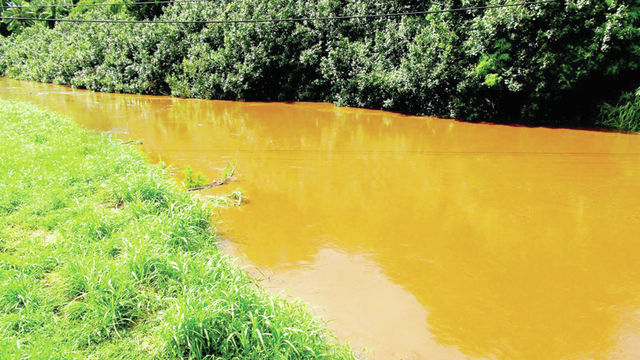KAPAA — Hanalei Bay’s blue hue has turned a yellowish brown, and state regulators say sediment runoff originating from the upper watershed are to blame. Heavy rains have transported sediment down the river and into the bay, prompting the issuance
KAPAA — Hanalei Bay’s blue hue has turned a yellowish brown, and state regulators say sediment runoff originating from the upper watershed are to blame.
Heavy rains have transported sediment down the river and into the bay, prompting the issuance of a brown water advisory Wednesday afternoon for Hanalei Bay.
More than 30,000 tons of eroded soil and sediment have fallen into the bay since the Hanalei River jumped its banks in 1995, according to the Department of Land and Natural Resources.
Over the years, this breach has caused numerous problems in the area, according to DLNR, including environmental pollution, loss of property, stream and reef degradation, and loss of water for nearby taro fields and the refuge.
A riverbank stabilization project is now underway with the goal of returning the river back to its original form by restoring the 100-foot section of eroded stream bank located on state land above the Hanalei Wildlife Refuge.
“The goal of the Hanalei River Restoration project is to restore a portion of the stream bank that breached in the mid 1990s and has continued to erode since then,” said Carty Chang, administrator of DLNR’s Engineering Division. “The breach has created a split flow condition in the river which, if not corrected, will cause further erosion of the breach section and continue to put adjacent homeowners’ properties and Hanalei Bay at risk.”
The project will also ensure a consistent flow of water in the Hanalei River which is the primary source used for taro cultivation and wetland habitat within the Hanalei National Wildlife Refuge, Chang added.
If left untreated, DLNR says the river would continue to carve a new channel across private and state-owned properties, and ultimately leave 1,000 feet of the Hanalei River dry.
Over the years, flood flows have repeatedly broken through emergency repairs, with the breach channel expanding after every major flood, according to DLNR.
For years, Hanalei biologist and videographer Terry Lilley, who is interested in the river as a nearby resident, has said that the mud flowing from the river was causing coral reef die-offs in the bay.
This week, when heavy rains began washing sediment into Hanalei River and Bay, Lilley grew concerned about the river restoration project and, in an email to residents and public officials, said the source of the sediment is not the upper watershed but rather a soil stockpile situated along the river about 100 yards from the Hanalei Bridge.
“With this last rain that we had all of the mud and soil from this restoration site just washed out into the river and out into Hanalei Bay,” Lilley told The Garden Island on Tuesday. “It’s probably one of the single worst disasters I’ve ever seen environmentally along the coastline.”
Lilley said he plans to file a complaint for violation of the Clean Water Act.
But Chang said Lilley’s claim that the sediment flooding into Hanalei River and Bay are from the restoration project is unfounded.
“We have been working closely with the U.S. Army Corps of Engineers and the Hawaii Department of Health to obtain all required permits and to ensure that all best management practices are in place,” Chang said. “We are in compliance and any concerns that the Hanalei Restoration Project is causing sediment runoff into the bay is inaccurate.”
The project has a National Pollutant Discharge Elimination System permit for land disturbance activities through the state Department of Health as well as a 401 Water Quality Certification permit issued by the Army Corp of Engineers for the in-water activities.
On Wednesday, two Clean Water Branch inspectors from the state Department of Health’s Enforcement Section inspected the project, according to DOH Spokeswoman Janice Okubo. The results of that inspection were not available by press time Wednesday. However, Okubo said the inspectors’ initial findings are not consistent with Lilley’s claim.
Earlier this month Lilley alerted residents and public officials in a series of emails about the soil stockpile, questioning the legality of its location, the potential environmental effects of rain washing the soil into the river and out into the bay and whether the soil had been tested for heavy metal and other toxins.
In response to Lilley’s concerns, the DOH’s Clean Water Branch started investigating the soil stockpile. The DOH has been monitoring the project for several months, along with the Army Corps of Engineers, according to DOH officials.
The DOH inquiry into the soil stockpile revealed that some sediment control best management practices were in place. DLNR has been using a silt fencing and filter socks along the perimeter of the stockpile where stormwater could potentially discharge soil into the river.
Based on its review of the site the DOH recommended that DLNR also use impervious sheeting on top of the soil to further prevent runoff into the river, DOH officials said.
The sediment does not appear to be located in a wetland or otherwise concerning area, according to the DOH.


